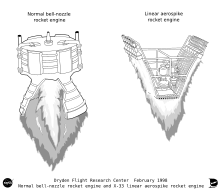Aerospike
Aero Spike ( Engl. "Air sting") is a rocket engine that is not on the principle of bell-shaped rocket nozzle based. The change in the nozzle principle enables an adaptation to the atmospheric air pressure at different flight altitudes. This adaptability enables the engine to be operated under optimal conditions. Aerospike engines have been researched since the mid-1950s. Due to the complexity of this type of engine, however, a prototype could not be developed until the 1990s with the X-33 program. There is currently no operational engine.
principle
A traditional engine uses a Laval nozzle to convert the heat from the exhaust gas into thrust. The thrust of a rocket engine is described by the following formula:
It is made up of the recoil force caused by the outflowing exhaust gas (product of exit speed and mass flow rate per time ) and the force that the remaining pressure exerts on the opening area of the nozzle. This pressure is the difference between the exhaust gas pressure and the pressure of the surrounding atmosphere .
With an optimal nozzle, the pressure of the exhaust gas corresponds to that of the atmosphere. If the atmospheric pressure is greater than that of the exhaust gas, one speaks of an over-expanding nozzle and, in the opposite case, of an under-expanding nozzle. A bell-shaped nozzle is designed for a certain altitude (atmospheric pressure) during a flight through an atmosphere and can therefore be under-, ideally and over-expanding during the flight or ascent.
The aerospike engine tries to circumvent this problem. Instead of evacuating the combustion gases through a nozzle on the bell base, the Aerospike uses several smaller, flat-oriented combustion chambers on the outside. A virtual bell is formed from the sting on one side and the air flowing past on the other - the air sting (aero-spike). The pressure of the exhaust gas flowing out can be varied accordingly by the mass flow rate and thus adapted to the ambient pressure of the atmosphere.
Advantages and disadvantages
advantages
- Aerospike theoretically uses up to 35% (low altitude) less fuel.
- The directional control works without complicated cardanic suspension of the engines or baffles in the hot exhaust jet, since the thrust of the external combustion chamber cells is simply controlled differently.
- By distributing the combustion over several small combustion chambers, the risk of an explosion is significantly reduced.
- An aerospike engine is lighter than a traditional one and only about half as high.
disadvantage
- The biggest problem in developing an aerospike engine is cooling the central cone. Shortening the spike reduces the impact by reducing the area that the combustion gases come into contact with. However, a shortening of the spine is always associated with a reduction in performance. A second air flow in the sting can in turn counteract this effect.
- In the case of a linear V-shaped aerospike engine, as it has been mostly used in tests up to now, there is a loss of performance due to vortex formation on the sides.
Tests and projects
Between 1950 and 1970, Rocketdyne , NASA and the US Air Force carried out a total of 73 tests with different sizes and variants.
The engine arrangement of the Soviet lunar rocket N1 produced an aerospike effect.
For NASA's X-33 VentureStar project , four XRS-2200 aerospike engines were developed on the basis of previous research and successfully tested from 1997 to 2000. However, the project was discontinued due to excessive costs and technical problems with the X-33.
The first known test flight of an aerospike engine was carried out as part of the Linear Aerospike SR-71 Experiment (LASRE) on October 31, 1997 on board a Lockheed SR-71 . However, the engine was not ignited.
In West Germany , work was being carried out on an aerospike engine for the Neptune spacecraft at the end of the 1960s .
In 2020 the TU Dresden and the Fraunhofer IWS started the CFDμSAT project for research on 3D-printed aerospike engines.
Web links
- Linear Aerospike Engine - Propulsion for the X-33 Vehicle. NASA ( Marshall Space Flight Center ), August 2008, accessed January 12, 2019 .
- vdi-nachrichten.com: Return of the Aerospike , February 12, 2020
Individual evidence
- ↑ a b Arash Naghib-Lahouti, Elhaum Tolouei: European Conference on Computational Fluid Dynamics - INVESTIGATION OF THE EFFECT OF BASE BLEED ON THRUST PERFORMANCE OF A TRUNCATED AEROSPIKE NOZZLE IN OFF-DESIGN CONDITIONS - Introduction. (PDF; 580 KB) Retrieved October 31, 2019 (English).
- ↑ a b Linear Aerospike Engine - Propulsion for the X-33 Vehicle. NASA ( Marshall Space Flight Center ), August 2008, accessed January 12, 2019 .
- ^ Yvonne Gibbs: NASA Armstrong Fact Sheet: Linear Aerospike SR-71 Experiment (LASRE) Project. NASA ( Armstrong Flight Research Center ), February 28, 2014, accessed November 18, 2017 .
- ↑ a b LASRE Test Flights End, VentureStar TM Aerodynamic Performance Predicted (press release). NASA ( Dryden Flight Research Center ), November 20, 1998, accessed November 18, 2017 .
- ↑ Aerospike engine for microlauncher. Raumfahrer.net, March 3, 2020, accessed on March 3, 2020 .










